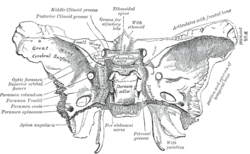| Foramen spinosum | |
|---|---|
 The inner surface of the sphenoid bone, with the foramen spinosum labelled at the left, second from the bottom. | |
 The inner surface of the base of the skull, with the sphenoid bone yellowed. The foramen spinosum is visible at the bottom right of the bone. | |
| Details | |
| Part of | Sphenoid bone |
| System | Skeletal |
| Identifiers | |
| Latin | foramen spinosum |
| TA98 | A02.1.05.038 |
| TA2 | 624 |
| FMA | 53156 |
| Anatomical terms of bone | |
The foramen spinosum is a small open hole in the greater wing of the sphenoid bone that gives passage to the middle meningeal artery and vein, and the meningeal branch of the mandibular nerve (sometimes it passes through the foramen ovale instead).
Contents
- Structure
- Contents
- Relations
- Variation
- Development
- Animals
- Function
- Clinical significance
- History
- See also
- References
- External links
The foramen spinosum is often used as a landmark in neurosurgery due to its close relations with other cranial foramina. It was first described by Jakob Benignus Winslow in the 18th century.
